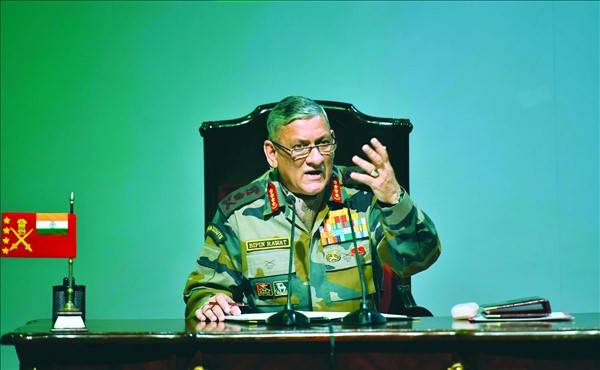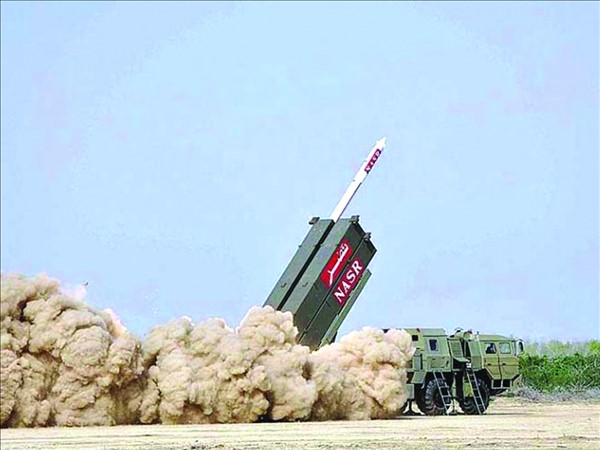
Indian Army Chief Gen Bipin Rawat’s statement about his willingness to “call Pakistan’s nuclear bluff” ratcheted up anxiety in Pakistan about the possibility of hawkish Indian leaders blustering their way towards a devastating confrontation.
The general’s threat did not come from a sudden rush of blood. Rather, it was part of a pattern of hostile statements that have been issued by Indian leadership against Pakistan.
The threat was met with a measured and comprehensive response from both the civilian and military leadership in Pakistan. The Indians were reminded not only of the existence of a credible nuclear deterrent, but also the immaturity of their top commander, who has been hurling threats in this manner.
How real is the threat?
It’s one thing to challenge the adversary to test the strength of our defenses—a line that was taken by Foreign Minister Khawaja Asif, who tweeted: “If that is what they desire, they are welcome to test our resolve. The general’s doubt would swiftly be removed, Inshallah.” ISPR Director General Maj Gen Asif Ghafoor too said: “Well it’s their choice. Should they wish to test our resolve they may try and see it for themselves.”
But then such threats cannot be ignored. The escalating rhetoric may be mere sabre-rattling, but it is at the same time indicative of what the enemy could be thinking. FO Spokesman Dr Muhammad Faisal had rightly noted that, “These are not issues to be taken lightly.”

India has already made its aggressive intentions towards Pakistan clear by committing 1,881 ceasefire breaches at the Line of Control and Working Boundary last year in which 87 civilians and troops were killed.
The nuclear weapons, many believe, have prevented Pakistan and India from going to an all-out war in the past nearly two decades despite crises taking them to the brink of open hostilities. However, one can’t be sure if the nukes would continue to prevent war or not. The deterrence stability of the region is already heavily strained because of Indian military modernization and build-up, nuclearization of the Indian Ocean Region, and developments in the ballistic missile shield.
There are few messages hidden in Gen Bipin’s words. He was, in reality, asserting the existence and relevance of the Cold Start Doctrine, a pro-active war fighting strategy, in which India has over the years invested heavily and undertaken the relevant logistical infrastructure development and force development to make it operational. There was an opinion that Pakistan had checkmated the Cold Start Doctrine by developing theater nuclear weapons, which can be used on the battlefield, the NASR missiles in our inventory.
But Gen Rawat is voicing the Indian opinion that even though Pakistan has developed short-range tactical missiles, they would be restrained from using them in the eventuality of Indian troops crossing the international border out of fear that India would retaliate with the use of battlefield nukes with a massive strike. That’s the Indian view, because they see the entire matter in the light of their own nuclear doctrine, which provides for a massive retaliation to cause unacceptable damage even in case of a limited use of nuclear weapons against it.
The other view – the Pakistani view – is that any aggression would be responded with full force and hence there is no question of holding back NASRs in case of Indian troops crossing over into Pakistani territory. They have been developed for that specific purpose.
And yet there is a completely different reading, one that was suggested by Indian scholar Prof Vipin Narang in a paper presented at a conference in Washington last March. He says that as per conventional wisdom, the likeliest path to the start of a nuclear conflict between Pakistan and India is one in which a group of terrorists attack an Indian city, resulting in casualties. The Indian government would order its troops to execute a cross-border action in Pakistan. Pakistani forces would hit back by firing battlefield nukes at the invading troops and in response India would plan massive retaliation.
At the same time, Narang has pointed to a shift in the Indian Nuclear Doctrine to giving up no-first use. He thinks India can also carry out pre-emptive strikes against Pakistan’s NASR batteries if they detect them being moved into the battlefield.
To prevent all these dreadful scenarios from turning into reality, both Pakistan and India need to immediately resume dialogue to address the outstanding issues. Unless that happens, there would always be fear of a terrorist attack setting off a negative chain of events, which no sensible person could ever think about.
As ill luck would have it, both civil and military mindsets in Delhi are equally offensive and have been dismissive of Pakistan’s offer for a resumption of dialogue. This Indian approach is being encouraged by the US that has been propping up India as a counterweight to China.
The writer is a freelance journalist based in Islamabad and can be reached at mamoonarubab@gmail.com and @bokhari_mr
The general’s threat did not come from a sudden rush of blood. Rather, it was part of a pattern of hostile statements that have been issued by Indian leadership against Pakistan.
The threat was met with a measured and comprehensive response from both the civilian and military leadership in Pakistan. The Indians were reminded not only of the existence of a credible nuclear deterrent, but also the immaturity of their top commander, who has been hurling threats in this manner.
Prof Vipin Narang says the likeliest path to the start of a nuclear conflict between Pakistan and India is one in which a group of terrorists attack an Indian city, resulting in casualties
How real is the threat?
It’s one thing to challenge the adversary to test the strength of our defenses—a line that was taken by Foreign Minister Khawaja Asif, who tweeted: “If that is what they desire, they are welcome to test our resolve. The general’s doubt would swiftly be removed, Inshallah.” ISPR Director General Maj Gen Asif Ghafoor too said: “Well it’s their choice. Should they wish to test our resolve they may try and see it for themselves.”
But then such threats cannot be ignored. The escalating rhetoric may be mere sabre-rattling, but it is at the same time indicative of what the enemy could be thinking. FO Spokesman Dr Muhammad Faisal had rightly noted that, “These are not issues to be taken lightly.”

India has already made its aggressive intentions towards Pakistan clear by committing 1,881 ceasefire breaches at the Line of Control and Working Boundary last year in which 87 civilians and troops were killed.
The nuclear weapons, many believe, have prevented Pakistan and India from going to an all-out war in the past nearly two decades despite crises taking them to the brink of open hostilities. However, one can’t be sure if the nukes would continue to prevent war or not. The deterrence stability of the region is already heavily strained because of Indian military modernization and build-up, nuclearization of the Indian Ocean Region, and developments in the ballistic missile shield.
There are few messages hidden in Gen Bipin’s words. He was, in reality, asserting the existence and relevance of the Cold Start Doctrine, a pro-active war fighting strategy, in which India has over the years invested heavily and undertaken the relevant logistical infrastructure development and force development to make it operational. There was an opinion that Pakistan had checkmated the Cold Start Doctrine by developing theater nuclear weapons, which can be used on the battlefield, the NASR missiles in our inventory.
But Gen Rawat is voicing the Indian opinion that even though Pakistan has developed short-range tactical missiles, they would be restrained from using them in the eventuality of Indian troops crossing the international border out of fear that India would retaliate with the use of battlefield nukes with a massive strike. That’s the Indian view, because they see the entire matter in the light of their own nuclear doctrine, which provides for a massive retaliation to cause unacceptable damage even in case of a limited use of nuclear weapons against it.
India has already made its aggressive intentions towards Pakistan clear by committing 1,881 ceasefire breaches at the Line of Control
The other view – the Pakistani view – is that any aggression would be responded with full force and hence there is no question of holding back NASRs in case of Indian troops crossing over into Pakistani territory. They have been developed for that specific purpose.
And yet there is a completely different reading, one that was suggested by Indian scholar Prof Vipin Narang in a paper presented at a conference in Washington last March. He says that as per conventional wisdom, the likeliest path to the start of a nuclear conflict between Pakistan and India is one in which a group of terrorists attack an Indian city, resulting in casualties. The Indian government would order its troops to execute a cross-border action in Pakistan. Pakistani forces would hit back by firing battlefield nukes at the invading troops and in response India would plan massive retaliation.
At the same time, Narang has pointed to a shift in the Indian Nuclear Doctrine to giving up no-first use. He thinks India can also carry out pre-emptive strikes against Pakistan’s NASR batteries if they detect them being moved into the battlefield.
To prevent all these dreadful scenarios from turning into reality, both Pakistan and India need to immediately resume dialogue to address the outstanding issues. Unless that happens, there would always be fear of a terrorist attack setting off a negative chain of events, which no sensible person could ever think about.
As ill luck would have it, both civil and military mindsets in Delhi are equally offensive and have been dismissive of Pakistan’s offer for a resumption of dialogue. This Indian approach is being encouraged by the US that has been propping up India as a counterweight to China.
The writer is a freelance journalist based in Islamabad and can be reached at mamoonarubab@gmail.com and @bokhari_mr

